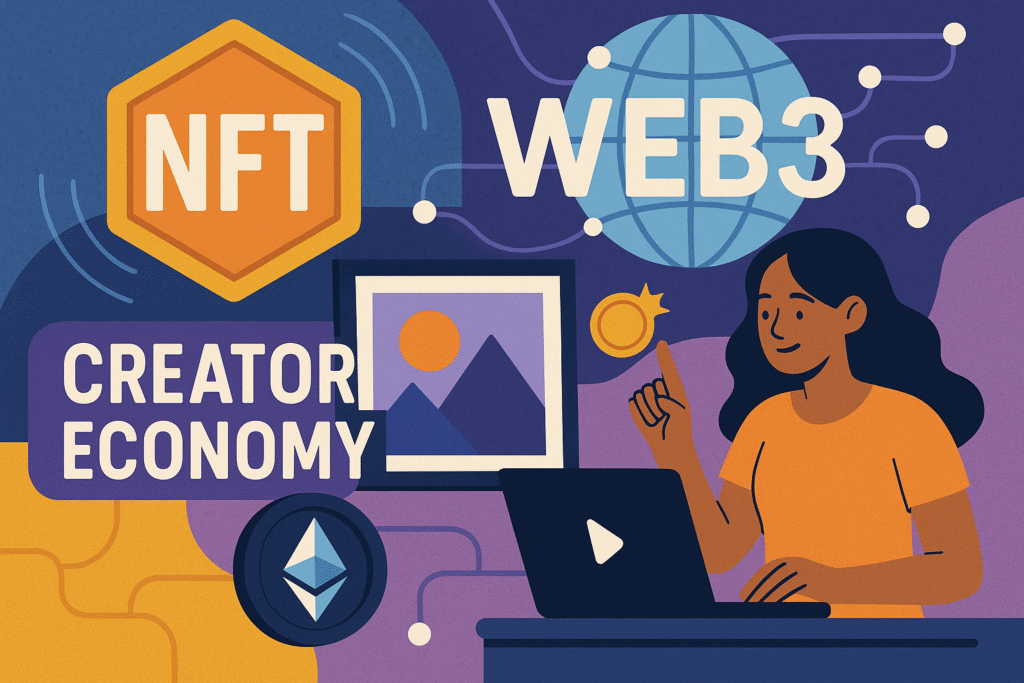When NFTs first exploded in 2021, many dismissed them as digital fads — overpriced images traded by crypto enthusiasts.
But four years later, the narrative has evolved.
In 2025, NFTs have matured into something far more powerful: infrastructure for ownership, identity, and monetization across the entire Web3 ecosystem.
And at the heart of this revolution lies the Creator Economy — an industry that’s shifting control away from centralized platforms and back into the hands of artists, musicians, writers, and entrepreneurs themselves.
This isn’t about pixel art anymore. It’s about economic independence.
From JPEGs to Digital Infrastructure
The NFT era began with collectibles — CryptoPunks, Bored Apes, and other digital art icons that captured mainstream attention.
But that was just the surface.
The real potential of NFTs lies in utility — in representing ownership, access, and authenticity in a digital world.
Today, NFTs are used to:
- Authenticate luxury goods and event tickets.
- Tokenize music, movies, and written content.
- Grant exclusive access to communities, metaverses, or virtual conferences.
- Represent real-world assets like real estate or intellectual property rights.
By combining blockchain transparency with smart contracts, NFTs have become programmable ownership certificates — assets that can prove who owns what, without intermediaries.
This functionality has turned NFTs into the building blocks of Web3 — not just collectibles, but identity keys for a new digital economy.

Web3: Redefining Digital Ownership
The foundation of Web3 — the next generation of the internet — is built on one radical idea:
You should own the things you create, share, and contribute to online.
In the Web2 era, platforms like YouTube, Instagram, and Spotify controlled distribution and monetization.
Creators built communities but rarely owned them.
In Web3, ownership and control are embedded directly into code.
Imagine:
- A musician releasing a song as a limited-edition NFT that automatically sends royalties to everyone who contributed.
- A writer monetizing access to their articles directly via blockchain subscriptions.
- A designer selling digital fashion that avatars wear across metaverse worlds.
This is the new Creator Economy, where creators don’t rent visibility — they own their audience and their revenue streams.
Platforms like Lens Protocol, Zora, and Sound.xyz are leading the way, allowing artists to publish, sell, and interact with fans without middlemen.
Monetization Beyond the Middleman
In 2025, traditional monetization models — ad revenue, sponsorships, and streaming royalties — are increasingly outdated.
They rely on centralized control, low transparency, and algorithms that favor engagement over value.
NFTs and Web3 disrupt that.
Through smart contracts, creators can:
- Set royalties for life, receiving a percentage every time their work resells.
- Fractionalize ownership, allowing fans to invest directly in projects they love.
- Launch DAO-based communities, where supporters vote on creative direction or revenue allocation.
It’s a shift from “audience as consumers” to “audience as partners.”
Example:
An indie filmmaker could fund a movie by selling NFTs that grant holders access to behind-the-scenes updates, voting rights, and profit-sharing from distribution — all tracked transparently on-chain.
This isn’t crowdfunding.
It’s co-ownership — and it’s changing the relationship between creators and their communities forever.
NFTs in the Real World: Utility Over Hype
As the speculative frenzy fades, NFTs are finding real-world utility in industries beyond art.
- Gaming: Players now truly own in-game items, transferable between titles and platforms.
- Fashion: Brands like Nike and Gucci issue NFTs for physical products, combining authentication with exclusive digital perks.
- Education: Certificates and diplomas are minted as NFTs, verifiable instantly across borders.
- Finance: Tokenized collectibles serve as collateral in decentralized lending markets.
Even governments and institutions are exploring NFT frameworks for identity verification, property titles, and event ticketing — use cases with real economic value.
NFTs are no longer speculative — they’re foundational.
Challenges Ahead: Sustainability and Accessibility
Despite the progress, Web3’s creator economy isn’t perfect.
Barriers to entry — such as technical complexity, gas fees, and platform fragmentation — still limit widespread adoption.
Environmental concerns, while improving with proof-of-stake blockchains, remain part of the conversation.
Moreover, the transition from centralized to decentralized systems requires education.
Creators must learn how to manage wallets, smart contracts, and digital communities — responsibilities that platforms once handled for them.
But as tools become more user-friendly and education improves, these barriers are falling fast.
Just as websites and social media democratized expression, NFTs and Web3 are democratizing digital ownership.
The Future: Ownership as a Universal Standard
In the next decade, we may stop calling them “NFTs” altogether.
Just as we don’t call digital files “web documents,” tokenized ownership will simply become the default.
Everything of value online — art, memberships, real estate, identities — will have a verifiable, transferable record on blockchain.
Creators won’t need to rely on ad revenue or platform algorithms to earn a living.
Instead, they’ll build self-sustaining ecosystems powered by tokenized participation — where every contribution, sale, or interaction generates value transparently.
The Web3 Creator Economy isn’t just about money.
It’s about freedom — financial, creative, and technological.
And for the first time in history, the internet finally belongs to its creators.
